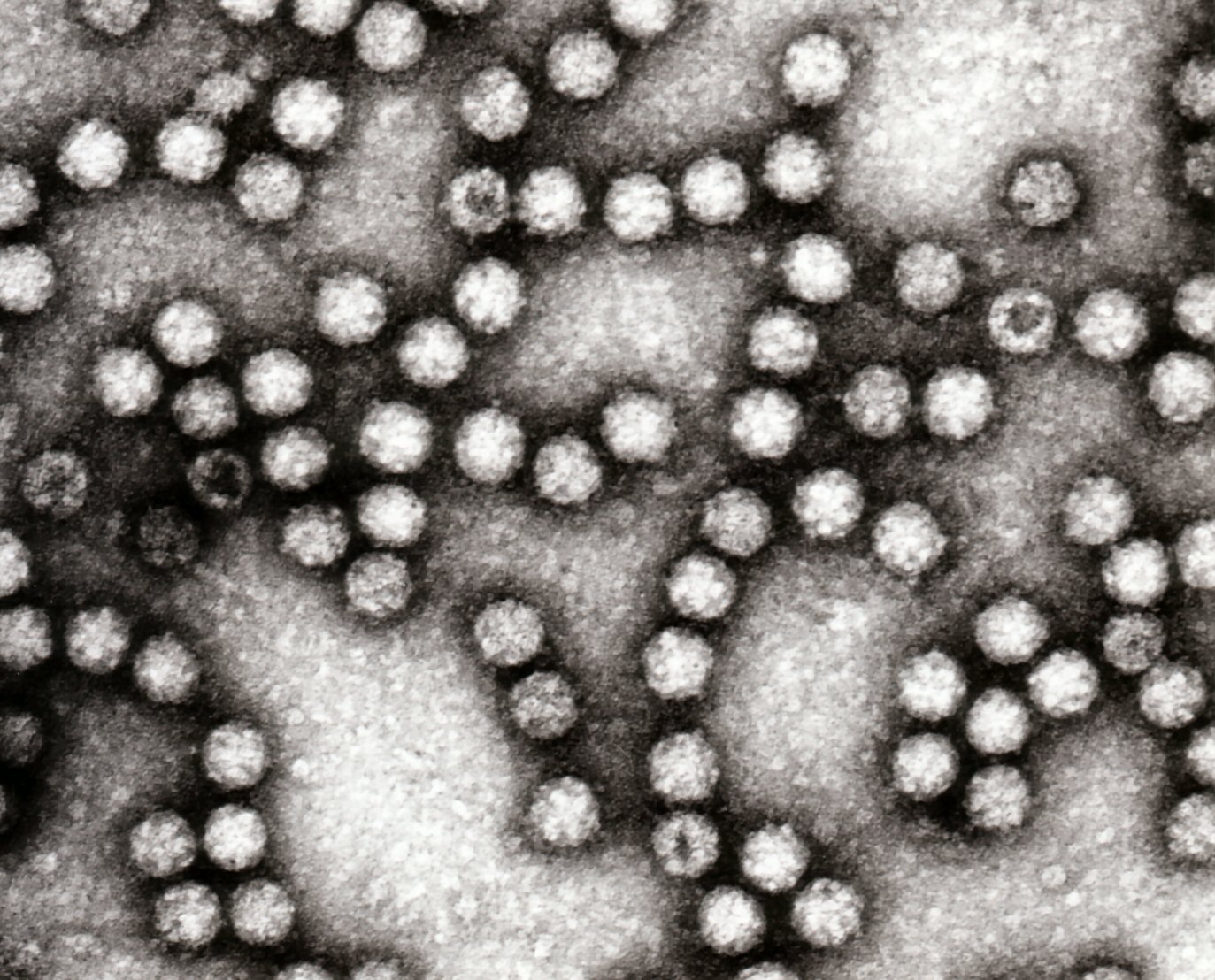- Astrovirus
image_width = 150px
image_caption = Electron micrograph of Astroviruses
virus_group = iv
familia = Astroviridae
subdivision_ranks = Species
subdivision = Genus: "Mamastrovirus":"Bovine astrovirus":"Feline astrovirus":"Human astrovirus":"Ovine astrovirus":"Porcine astrovirus":"Mink astrovirus"Genus: "Avastrovirus":"Chicken astrovirus":"Duck astrovirus":"Turkey astrovirus"Astrovirus is a type of
virus that infectsmammals andbirds . Astroviruses belong to the virus family "Astroviridae". They were first described in the year 1975 usingelectron microscopes during an outbreak ofdiarrhoea .cite journal
author=Madeley CR, Cosgrove BP
title=Letter: 28 nm particles in faeces in infantile gastroenteritis
journal=Lancet
volume=2
issue=7932
pages=451–2
year=1975
pmid=51251
doi=] Astrovirus has a non-segmented, single stranded, positive senseRNA genome within a non-envelopedicosahedral capsid .cite journal
author=Matsui SM, Kiang D, Ginzton N, Chew T, Geigenmüller-Gnirke U
title=Molecular biology of astroviruses: selected highlights
journal=Novartis Found. Symp.
volume=238
issue=
pages=219–33; discussion 233–6
year=2001
pmid=11444028
doi=]igns and symptoms of human disease
Members of a relatively new virus family, the astroviridae, astroviruses are now recognised as a cause of
gastroenteritis in children and adults. The main symptoms arediarrhoea , followed by nausea,vomiting ,fever , malaise and abdominal pain. Some research studies have shown that the duration of the symptoms are approximately three to four days.Astrovirus infection is not usually a severe situation and only in some rare cases leads todehydration . Infected people do not need hospitalization because symptoms reduce by themselves, after a small period of time.cite journal
author=Madeley CR
title=Virus diarrhoea in hospital
journal=J. Hosp. Infect.
volume=12
issue=3
pages=145–9
year=1988
pmid=2904454
doi=10.1016/0195-6701(88)90001-1]Diagnosis
Electron microscopy , enzyme-immunoassay (ELISA ),immunofluorescence , andpolymerase chain reaction have all been used. These detect virus particle, antigens or viral nucleic acid in the stools of infected people.cite journal
author=Guix S, Bosch A, Pintó RM
title=Human astrovirus diagnosis and typing: current and future prospects
journal=Lett. Appl. Microbiol.
volume=41
issue=2
pages=103–5
year=2005
pmid=16033504
doi=10.1111/j.1472-765X.2005.01759.x
url=http://www.blackwell-synergy.com/openurl?genre=article&sid=nlm:pubmed&issn=0266-8254&date=2005&volume=41&issue=2&spage=103]Epidemiology
A study of intestinal disease in the UK, published in 1999 determined incidence as 3.8/1000 patient years in the community (95%CI, range2.3-6.4), the fourth most common known cause of viral gastroenteritis.cite journal
author=
title=Infectious diseases in England and Wales: January to March 1999
journal=Commun. Dis. Rep. CDR Suppl.
volume=9
issue=4
pages=S1–20
year=1999
pmid=10434464
doi=] Studies in the USA have detected astroviruses in the stools of 2-9% of children presenting symptoms; illness is most frequent in children of less than two years, although outbreaks among adults and the elderly have been reported. Early studies carried out inGlasgow demonstrated that a significant proportion of babies excreting virus particles, 12%, did not exhibit gastrointestinal symptoms, andseroprevalence studies carried out in the US have shown that 90% of children have antibody toHastV-1 by age 9, suggesting that (largely asymptomatic) infection is common. There is, as with most viral causes of gastroenteritis, a peak of incidence in the winter.cite journal
author=Glass RI, Noel J, Mitchell D, "et al"
title=The changing epidemiology of astrovirus-associated gastroenteritis: a review
journal=Arch. Virol. Suppl.
volume=12
issue=
pages=287–300
year=1996
pmid=9015126
doi=]Humans of all ages are susceptible to astrovirus infection but children, the elderly and those that are
immunocompromised are most prone. The majority of children have acquired astrovirusantibodies by the age of 5 and looking at the pattern of disease, it suggests that antibodies provide protection through adult life, until the antibody titre begins to decline later in life.cite journal
author=Koopmans MP, Bijen MH, Monroe SS, Vinjé J
title=Age-stratified seroprevalence of neutralizing antibodies to astrovirus types 1 to 7 in humans in The Netherlands
journal=Clin. Diagn. Lab. Immunol.
volume=5
issue=1
pages=33–7
year=1998
pmid=9455876
doi=
url=http://cvi.asm.org/cgi/pmidlookup?view=long&pmid=9455876] cite journal
author=Midthun K, Greenberg HB, Kurtz JB, Gary GW, Lin FY, Kapikian AZ
title=Characterization and seroepidemiology of a type 5 astrovirus associated with an outbreak of gastroenteritis in Marin County, California
journal=J. Clin. Microbiol.
volume=31
issue=4
pages=955–62
year=1993
pmid=8385155
doi=
url=http://jcm.asm.org/cgi/pmidlookup?view=long&pmid=8385155] Astroviruses cause disease worldwide, and they are second only torotavirus es as the cause of childhood diarrhoea. The occurrence of astrovirus infection varies depending on the season. Intemperate climates infection is highest during winter months. This is in contrast totropical regions where prevalence is highest during the rainy season. This seasonal distribution of infection in temperate climates is rather puzzling. But the seasonal distribution in tropical climates can be explained by the impact of the rain particularly on breakdown ofsanitation in developing countries.cite journal
author=Glass RI, Noel J, Mitchell D, "et al"
title=The changing epidemiology of astrovirus-associated gastroenteritis: a review
journal=Arch. Virol. Suppl.
volume=12
issue=
pages=287–300
year=1996
pmid=9015126
doi=]The main mode of Astrovirus transmission is by contaminated food and water. Young children in childcare backgrounds or adults in military barracks are most likely to develop the disease.
Prevention
There is no
vaccine or anti-viral treatment against the Astrovirus infection but personal hygiene can reduce the incidence of the illness.Microbiology
Taxonomic structure
The family "Astroviridae" contains two genera: "Mamastroviruses" which infect mammals, and "Avastroviruses" which infect birds. Within each genus, there are
species of astroviruses, each of which is named after the host in which they replicate. The astroviruses are further subclassified within each species into serotypes.cite journal
author=Lukashov VV, Goudsmit J
title=Evolutionary relationships among Astroviridae
journal=J. Gen. Virol.
volume=83
issue=Pt 6
pages=1397–405
year=2002
pmid=12029155
doi=
url=http://vir.sgmjournals.org/cgi/pmidlookup?view=long&pmid=12029155]Virus structure
Astroviruses have a star like appearance with 5 or 6 points and their name is derived from the Greek word “astron” meaning star. They are non-enveloped
RNA viruses with cubiccapsid s, approximately 28-30nm in diameter.cite journal
author=Krishna NK
title=Identification of structural domains involved in astrovirus capsid biology
journal=Viral Immunol.
volume=18
issue=1
pages=17–26
year=2005
pmid=15802951
doi=10.1089/vim.2005.18.17]Genome
Astroviruses have a
genome composed of a single strand of positive senseRNA . The single strand of RNA has apoly A tail at the3' end , but no5' cap . With the exclusion of polyadenylation at the3' end , the genome is between 6.8-7.9 kb long. The genome is arranged into 3open reading frame s (ORF s), with an overlap of approximately 70 nucleotides between ORF1a and ORF1b. The remaining ORF is known as ORF2.cite journal
author=Willcocks MM, Brown TD, Madeley CR, Carter MJ
title=The complete sequence of a human astrovirus
journal=J. Gen. Virol.
volume=75 ( Pt 7)
issue=
pages=1785–8
year=1994
pmid=8021608
url=http://vir.sgmjournals.org/cgi/pmidlookup?view=long&pmid=8021608]References
Wikimedia Foundation. 2010.

